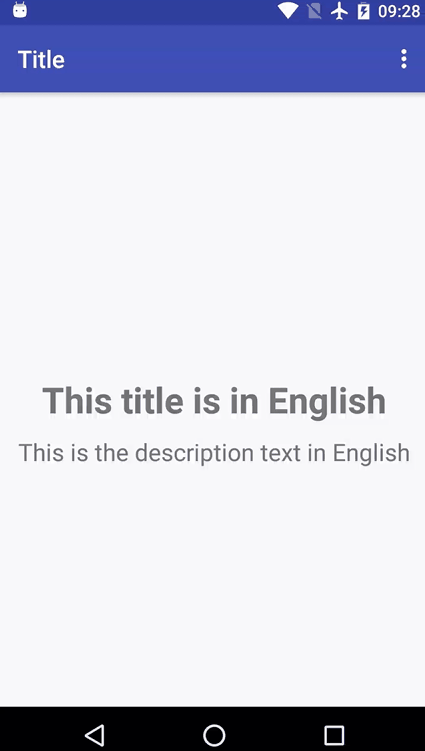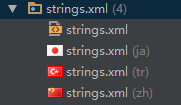App内切换语言详解
前几天客户提需求,对App增加一个功能,这个功能目前市面上已经很常见,那就是应用内切换语言。啥意思,就是 英、中、法、德、日。。。语言随意切换。
(本案例采用Data-Bingding模式,麻麻再也不用担心我findViewBy不到Id了哈哈,开个玩笑)
先上示例图:

代码实现:
布局文件(Data-Binding模式),很简单就是两行文字
<?xml version="1.0" encoding="utf-8"?> <layout xmlns:android="http://schemas.android.com/apk/res/android"> <RelativeLayout xmlns:tools="http://schemas.android.com/tools" android:layout_width="match_parent" android:layout_height="match_parent" tools:context="com.tnnowu.android.switchlanguage.MainActivity"> <TextView android:id="@+id/titleTextView" android:layout_width="wrap_content" android:layout_height="wrap_content" android:layout_centerInParent="true" android:text="@string/title" android:textSize="30sp" android:textStyle="bold" /> <TextView android:id="@+id/descTextView" android:layout_width="wrap_content" android:layout_height="wrap_content" android:layout_below="@+id/titleTextView" android:layout_centerHorizontal="true" android:layout_marginTop="10dp" android:text="@string/desc" android:textSize="20sp" /> </RelativeLayout> </layout>
从实例中我们可以看到右上角是有Menu
<?xml version="1.0" encoding="utf-8"?> <menu xmlns:android="http://schemas.android.com/apk/res/android" xmlns:tools="http://schemas.android.com/tools" tools:context=".MainActivity"> <item android:id="@+id/language_english" android:orderInCategory="100" android:title="@string/menu_english" /> <item android:id="@+id/language_simplified_chinese" android:orderInCategory="100" android:title="@string/menu_simplified_chinese" /> <item android:id="@+id/language_turkish" android:orderInCategory="100" android:title="@string/menu_turkish" /> <item android:id="@+id/language_japanese" android:orderInCategory="100" android:title="@string/menu_japanese" /> </menu>
(既然是多语言,所以就要有N个strings)

本案例我创建了4种语言。
好的,Menu的布局写完了,接下来就是实现Menu功能,记住实现Menu就两套代码,一个 onCreateOptionsMenu , 另一个是 onOptionsItemSelected 。
@Override
public boolean onCreateOptionsMenu(Menu menu) {
getMenuInflater().inflate(R.menu.menu, menu);
return true;
}
@Override
public boolean onOptionsItemSelected(MenuItem item) {
int id = item.getItemId();
if (id == R.id.language_english) {
updateViews("en");
} else if (id == R.id.language_simplified_chinese) {
updateViews("zh");
} else if (id == R.id.language_turkish) {
updateViews("tr");
} else if (id == R.id.language_japanese) {
updateViews("ja");
}
return super.onOptionsItemSelected(item);
}
在这里,可以看到,我们自定义一个 updateViews() 方法,用来实现切换预言时界面的改变
private void updateViews(String languageCode) {
Context context = LocaleHelper.setLocale(this, languageCode);
Resources resources = context.getResources();
mBinding.titleTextView.setText(resources.getString(R.string.title));
mBinding.descTextView.setText(resources.getString(R.string.desc));
setTitle(resources.getString(R.string.toolbar_title));
}
公布一个 语言判断的类 LocaleHelper
public class LocaleHelper {
private static final String SELECTED_LANGUAGE = "Locale.Helper.Selected.Language";
public static Context onAttach(Context context) {
String lang = getPersistedData(context, Locale.getDefault().getLanguage());
return setLocale(context, lang);
}
public static Context onAttach(Context context, String defaultLanguage) {
String lang = getPersistedData(context, defaultLanguage);
return setLocale(context, lang);
}
public static String getLanguage(Context context) {
return getPersistedData(context, Locale.getDefault().getLanguage());
}
public static Context setLocale(Context context, String language) {
persist(context, language);
if (Build.VERSION.SDK_INT >= Build.VERSION_CODES.N) {
return updateResources(context, language);
}
return updateResourcesLegacy(context, language);
}
private static String getPersistedData(Context context, String defaultLanguage) {
SharedPreferences preferences = PreferenceManager.getDefaultSharedPreferences(context);
return preferences.getString(SELECTED_LANGUAGE, defaultLanguage);
}
private static void persist(Context context, String language) {
SharedPreferences preferences = PreferenceManager.getDefaultSharedPreferences(context);
SharedPreferences.Editor editor = preferences.edit();
editor.putString(SELECTED_LANGUAGE, language);
editor.apply();
}
@TargetApi(Build.VERSION_CODES.N)
private static Context updateResources(Context context, String language) {
Locale locale = new Locale(language);
Locale.setDefault(locale);
Configuration configuration = context.getResources().getConfiguration();
configuration.setLocale(locale);
return context.createConfigurationContext(configuration);
}
@SuppressWarnings("deprecation")
private static Context updateResourcesLegacy(Context context, String language) {
Locale locale = new Locale(language);
Locale.setDefault(locale);
Resources resources = context.getResources();
Configuration configuration = resources.getConfiguration();
configuration.locale = locale;
resources.updateConfiguration(configuration, resources.getDisplayMetrics());
return context;
}
}
最后还要做的操作就是,自定义一个Application类,用来设定App的默认语言(当然了,要将这个Application应用到Manifest中)
public class BaseApplication extends Application {
@Override
protected void attachBaseContext(Context base) {
super.attachBaseContext(LocaleHelper.onAttach(base, "en"));
}
}
本案例实现App内语言切换代码量不大,通俗易懂,无垃圾代码。
示例代码下载地址:App内切换语言
以上就是本文的全部内容,希望本文的内容对大家的学习或者工作能带来一定的帮助,同时也希望多多支持我们!
赞 (0)

